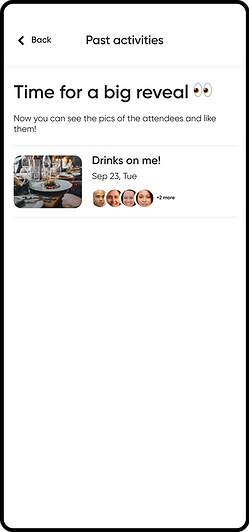
UX DESIGN PROJECT

PROJECT OVERVIEW
Socio is a revolutionary dating app that redefines connection through shared activities. By focusing on collaborative experiences, Socio eliminates the need for tedious messaging, encouraging users to create and join activities effortlessly. The app introduces a unique feature where user profiles remain picture-hidden in group events, fostering genuine connections preventing visual biases. Socio prioritizes the essence of interpersonal connections, whether through dynamic group activities or traditional matches with shared interests. Embracing a philosophy of meaningful engagement, Socio transforms the dating landscape by inspiring users to build connections through shared experiences rather than superficial impressions.
My Role
Time
Research/Collaboration
-
Research
-
Ideate
-
Design
-
Prototyping
-
Testing & Iterations
-
Eva Cook
-
Dianela Gahn
4 weeks
PROCESS


01
RESEARCH
User Inverviews
We decided to start with conducting a user interview with 10 regular users of different dating apps. We aimed to target people from different backgrounds and gender. Here are some of the q’s 👉

Some of the key findings from initial user research was 👇
-
Users don’t want to spend too much time on the dating apps messaging back and forth without knowing if they’d ever meet
-
Users want to see if they have a chemistry or not as fast as they can.
-
Users want to attend activities together as a group to remove stress of the going to first date one to one
-
They want to connect in real life rather than losing time on apps without knowing if they would attracted to each other in real life.
-
Users are afraid of judging people by their profile pic and maybe missing out some amazing connections
-
Users also don't want to pay a lot more to use the premium options that app only offers to the paid customers.
Following the user interviews, our research team start the phase of affinity mapping to organize the insights gathered. This process involves charting out responses to various questions, identifying patterns, and figuring out the concepts that resonate across user feedback. As we delve into the grouping process, similarities and thematic connections among user responses begin to emerge, laying the foundation for clusters of related insights.
As the affinity mapping process unfolds, the concepts within each group evolve into actionable insights and design problems start to appear within each group. We transition from the raw data of individual responses to an overarching user needs. This journey from raw data to insights helps our team to make informed decisions in shaping user-centric solutions.

02
IDEATE
Personas
After having number of user interviews and researching on demographics of our users we had a variety of user profiles and information about their choices, preferences, habits, goals, needs and pain points. Later on each of us come up with different personas that will guide our design decisions separately. Based on these different profiles we decided to ideate our design solutions.

User Journey Map
Starting with the user's initial touchpoint, the journey map elegantly captures the user's progression through various phases. Each stage is enriched with insights from the affinity mapping and the persona, shedding light on the motivations, expectations, and challenges users encounter. This holistic view allows us to empathize with users, viewing our product or service through their lens.

Empathy Map
The empathy map is typically divided into four key quadrants: "Says," "Thinks," "Feels," and "Does." In the "Says" part, we articulate the statements and expressions of our persona might vocalize at each stage. "Thinks" delves into their internal thoughts, providing a glimpse into their mindset. "Feels" captures the emotional spectrum, detailing the highs and lows experienced. Finally, "Does" outlines the actions and behaviors exhibited by our persona throughout their journey.

Brainstorming the solutions 👇
Concepts
-
Active
-
Transparent
-
Fun
-
Genuine
Solutions
-
Helping them with reducing the time spent on messaging
-
Group activities and events to make multiple people meet at once.
-
Preventing the bias based on the pics
-
Fun activities together

03
DESIGN
Some of the key features to begin with 👇


Low to mid-fi designs
First couple of features on the sketches to go on testing 👇


Style Guide/ Design library

04
PROTOTYPE & TESTING
Testing
Testing results after the testing session 👇

Iterations
What went wrong? 🙅♀️




05
FINAL DESIGN
New Design
Coming clean 🫡
Creating account easily 👤




🪄
Add more interests
Users can be able to add their specific hobbies, activities, and life style choices specifically by add more button.




👌
Couple of more steps
Couple of more steps to go through and your profile is completed! Users can start matching with potential matches.
💑
Home page
You can see the detailed profiles of your potential matches on home page, match with them and invite them to activities.




🏄♂️
Activity based match
On the home page you can match with activities to attend with a group of people.
⚡️
Attend and create activities
On the activity page you can join or create your own activity and you can either invite your matches or people can join it with matching it.




🗓️
Schedule your activities
You can check your upcoming activities from your schedule or see your past activities!
👻
Time for a big reveal
After joining an activity you can be able to see the attendees' profiles and like their profile to match with them. 👩❤️👨




✍️
Start chatting
You can chat with your matches on the chat page and see who liked you from the past events!
Final thoughts for future improvements 🧠
-
On the schedule page users might be able to see the activities they created and edit the activity
-
After user matched with someone they can able to create n activity to send them
-
Group chats for activities?
-
On the activity page users again might be able to see their own activities
-
When you attend an activity you might be able to share it with your matches.


